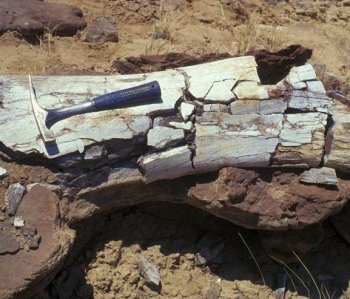Scientists have unearthed a dinosaur bone dated to be 64.8 million years old, according to a study published online Jan. 26 in Geology.
The fossil is a femur bone of the sauropod species Alamosaurus sanjuanensis. The species is a herbivorous dinosaur that can reach up to 20 meters (about 67 feet) in length.
The bone was dated using uranium-lead (U-Pb) dating, “based on the decay of two different U-isotopes, 238U and 235U,” Dr. Larry Heaman of the University of Alberta in Canada told The Epoch Times. “These two isotopes decay at a known rate over time to two lead isotopes, 206Pb and 207Pb respectively.”
“What is new about our approach to dating dinosaur bone is that we use relatively new technology to measure the uranium and lead isotopic composition of bone,” said Heaman.
“This new technology is called laser ablation inductively coupled plasma mass spectrometry. We prepare a thin slice of the bone and then aim a 160-micron-diameter laser beam at selected parts. The laser pulses liberate tiny particles from the bone. These particles are transported to a plasma where they are dissociated and ionized. The ionized particles are accelerated into a mass spectrometer and the isotopic composition of lead is determined.”
This technique allows the fossil to be dated directly, as apatite, which is a major component of bone mineral, can incorporate uranium, Heaman said. This makes the dating more accurate than other methods that determine the age of fossils from substances in the surrounding area.
“The new technique we developed is more accurate than previous unsuccessful attempts at direct dating of bone because the geochemistry of bone can be complex and disturbed by interaction with fluids subsequent to fossilization,” he said.



